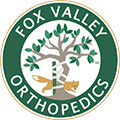Your Guide to Preventing Sports Injuries
- Category: Blog
- Posted On:
- Written By: Fox Valley Orthopedics

Whether you're a weekend warrior or training to be an olympic athlete, everyone is prone to sustaining a sports injury. Follow these tips to keep you on your feet and in the game.
Most Common Orthopedic Sports Injuries
Everyone is at risk of sustaining a sporting injury, regardless of their athletic ability. However, the first step in preventing these injuries is understanding what they are and how they happen.
Sprains
Sprains are injuries that affect your ligaments. These injuries occur when a ligament is overstretched or torn as a result of trauma. Symptoms may include:
- Pain and tenderness at the site of injury
- Swelling
- Bruising and discoloration
- Inability to move affected joint
- A “pop” sound that the time of injury
Strains
Strains are orthopedic injuries that affect muscles or tendons. They occur when a muscle or tendon is overstretched or torn. Typically, strains tend to develop as a result of a specific incident or trauma. Symptoms of a strain may include:
- Pain and tenderness at the site of injury
- Muscle spasms
- Swelling
- Trouble moving the affected muscle
Breaks and Fractures
When bones experience excessive external force or pressure, breaks and fractures occur. Broken bones are most commonly caused by direct trauma, overuse, or osteoporosis. Common symptoms associated with a broken bone may include:
- Inability to move the affected area
- Swelling
- Bruising
- Visual deformity
Dislocations
Dislocations are joint injuries that happen when excessive force is applied to your joint to the point where the ends of your bones move out of position. Common symptoms of a dislocated joint include:
- Severe pain
- Swelling
- Visibly out of place
- Inability to move the affected area
If you suspect that you may have sustained a dislocated joint, you should see an orthopedic specialist immediately.
Properly warm-Up Before Exercise
Warming up your body before participating in your main form of exercise can not only improve your athletic performance but can reduce your risk of sustaining an avoidable injury. By gradually raising your muscle’s internal temperatures, you increase your flexibility. This then leaves you less likely to sustain strains, sprains, and other orthopedic injuries.
A proper warm-up should be between 5 and 10 minutes before your main physical activity routine. Some examples of warm-up activities include:
- High-knees
- Jogging
- Lateral lunges
- Squat-jumps
- Jumping jacks
- Plank walk-outs
Use Proper Form and Technique
When warming up, it is imperative that you use proper form and technique to reduce your risk of injury. Improper form can result in damage to your joints, ligaments, and muscles. If you are unsure how to perform a new exercise, consult an athletic trainer or a sports medicine professional to make sure you’re on the right track.
Taking Rest Days
While staying active is often referred to as one of the best ways to maintain physical health, taking days off can also help you to reduce your risk of injury. Whether you're a weekend warrior or a professional athlete, taking rest days is essential to maintaining your bone and joint health.
Taking a day off not only gives you a chance to relax, but your body is actually recovering. When you work out and push your body to its limits, your muscles experience microscopic tears. When you're resting, your fibroblast cells work to help affected tissues to heal and grow.
Here are some tips to help you have a successful rest day:
- Use dynamic stretching techniques.
- Use a foam roller.
- Drink plenty of water.
- Take a warm bath.
Eat a Healthy Diet
The foods we eat directly impact the health and resilience of the various systems in our bodies—including the musculoskeletal system. Try adding these foods to your shopping list to help keep your bones, joints, and muscles healthy and strong.
Calcium and Vitamin D
While many have heard that calcium helps to support strong bones, it also helps to support healthy muscle contraction, enables blood-clotting, and even helps to support heart health.
Because our bodies cannot produce calcium by themselves, it is imperative that we get the recommended amounts by eating a balanced diet. Foods that are rich in calcium include:
- Dairy products like milk, cheese, and yogurt
- Leafy green vegetables like kale, spinach, and collard greens
- Bony fish like sardines
- Tofu
- Soybeans
- Nuts like almonds and walnuts
While calcium plays an important role in supporting your musculoskeletal health, vitamin D is just as important. Vitamin D helps your body absorb calcium from the foods that you eat and also helps to support the muscles that protect your bones. Foods rich in vitamin D include:
- Fatty fish like tuna and mackerel
- Mushrooms
- Egg yolks
- Foods fortified with vitamin D such as milk, orange juice, and cereals
Protein
Proteins are widely known for supporting strong and healthy muscles, however, they also help to support bone health. Your muscles and bones not only provide structural support for your body, but they also allow the body to move. Proteins can be found in the following foods:
- Poultry such as chicken and turkey
- Red meats like beef and lamb
- Fish like cod and salmon
- Eggs
- Beans
- Nuts and seeds like almonds and sesame seeds
- New plant and collagen-based proteins that have become popular recently
Orthopedic Care in Fox Valley
At Fox Valley Orthopedics, we can help you get back to a pain-free, comfortable life. If you have been dealing with aches and pains that have lasted for more than a week, don’t put off getting help another day. Call (630) 584-1400 today to schedule your appointment.


